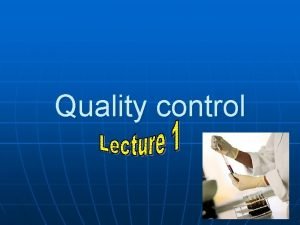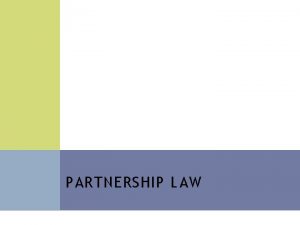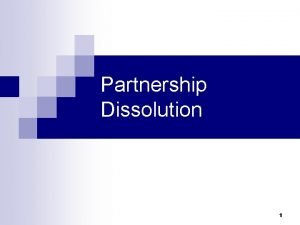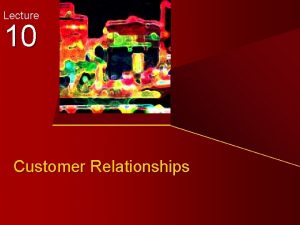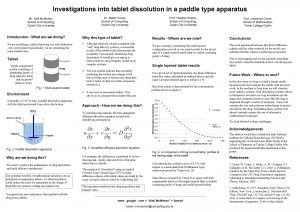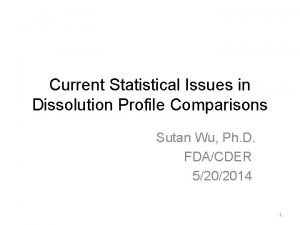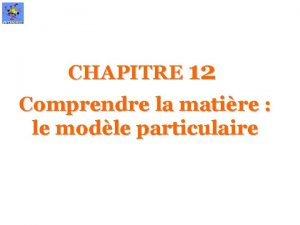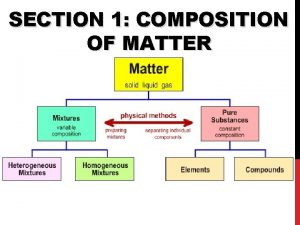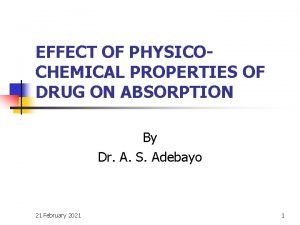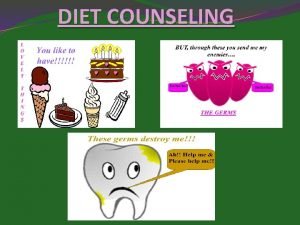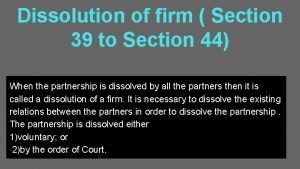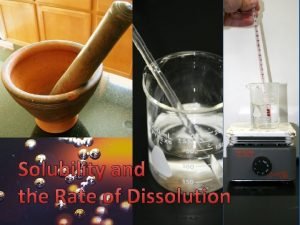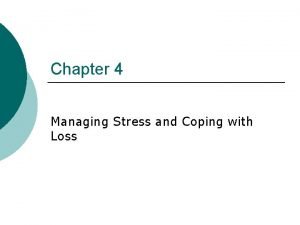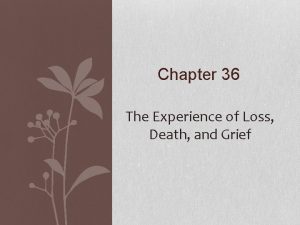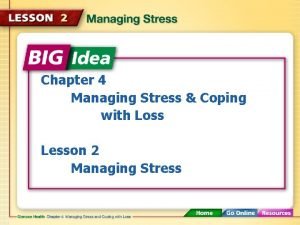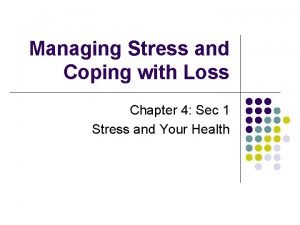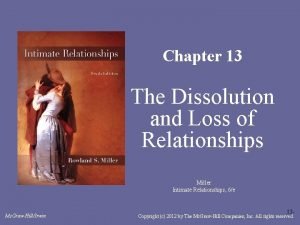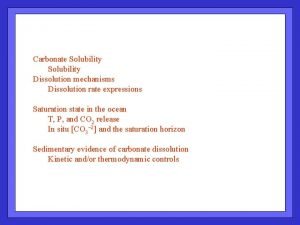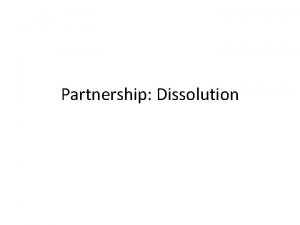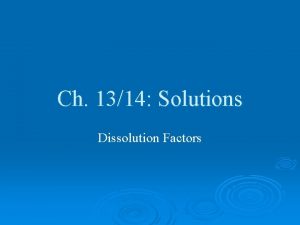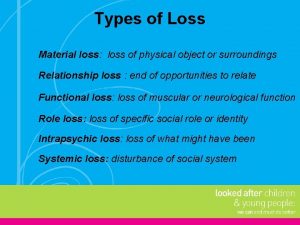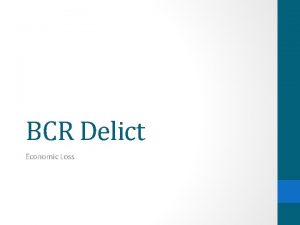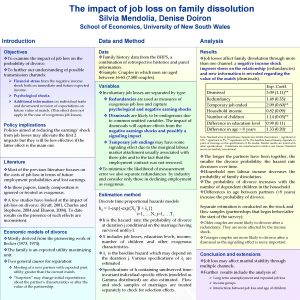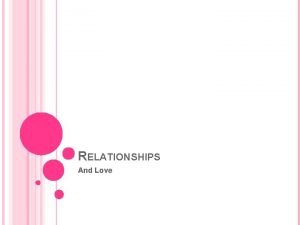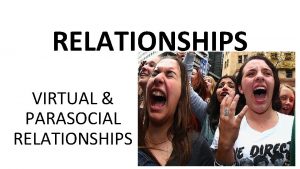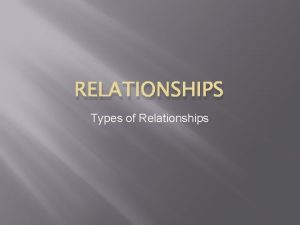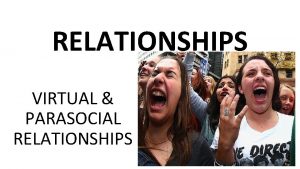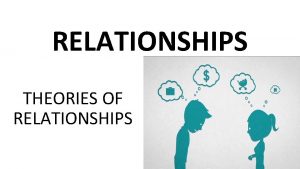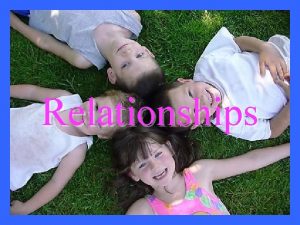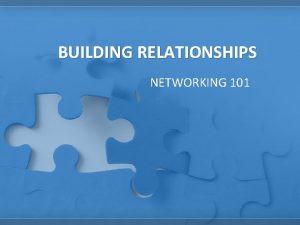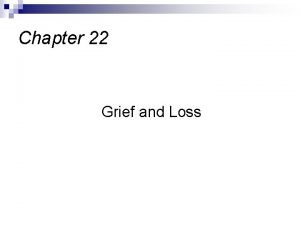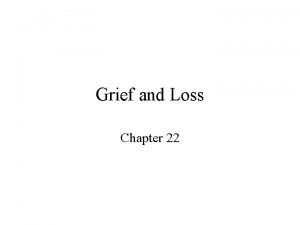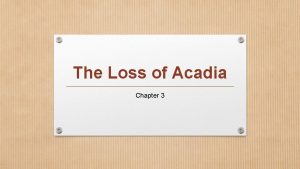Chapter 13 The Dissolution and Loss of Relationships










































- Slides: 42

Chapter 13 The Dissolution and Loss of Relationships Miller Intimate Relationships, 6/e Mc. Graw-Hill/Irwin Copyright (c) 2012 by The Mc. Graw-Hill Companies, Inc. All rights reserved.

The Changing Rate of Divorce The Prevalence of Divorce The current rate of divorce in the U. S. is a bit lower than it was at its peak back in 1980, but the chance that a recent marriage will ultimately end in separation or divorce is still close to 50%. Despite all the good intentions and warm feelings with which people marry, the chances that they will succeed in living out their lives together are about the same as the chance of getting “heads” when you flip a coin. 13 -2

Historical Perspective • Relationships exist in a larger Context – Question: • When was the highest divorce rate in U. S. ? • When was the lowest divorce rate in U. S. ? » Why? ? » » » Role of Economy, time, health, and education - Poverty and Divorce Rate Unemployment: 2 x Divorce Likelihood Shift Workers/Dual Income: Intimacy costs? Federal Policy on Marriage: Poverty Buffer 13 -3

The Changing Rate of Divorce The Consequences of Divorce 11% of adult women in the U. S. is presently divorced 30% of Children do not live with Biological Father 13 -4

The Changing Rate of Divorce U. S. Divorce Rates in Comparative Perspective Divorce rates increased in most Western countries in the 20 th century, but divorces are much more common in the U. S. than in most other countries. Marriages are much less likely to end than other romantic relationships are (see box, “The Staying Power of Formal Commitment” in Intimate Relationships, 6 e), but they are also less likely to last than they used to be. 13 -5

The Changing Rate of Divorce Why Has the Divorce Rate Increased? Cultural influences may underlie the big increase in American divorce: – Demanding expectations – People may expect more out of marriage than they used to. Marriage is supposed to be play, not work, and passionate, not placid. – Women work outside the home – Both spouses now have access to money and alternative partners, and an independence hypothesis suggests that the economic freedom to divorce generally makes divorce more likely. 13 -6

The Changing Rate of Divorce Why Has the Divorce Rate Increased? – Gender roles are changing – Women are becoming more assertive and self-reliant… …and men are doing more housework. – Western culture is more individualistic – Disconnected from our communities, we rely on our spouses for more social support than ever before. 13 -7

The Changing Rate of Divorce Why Has the Divorce Rate Increased? – Sex ratios are lower – A surplus of women encourages men to be less committed to any one partner. – Divorce is less shameful and easier to obtain – We tend to feel that a no-fault divorce is a more reasonable and more desirable response to a bad marriage than our grandparents did. – Cohabitation is more prevalent – Casual cohabitation leads to less respect for marriage and increases people’s willingness to divorce. 13 -8

The Changing Rate of Divorce Why Has the Divorce Rate Increased? – There are more children of divorce – And children who experience the divorce of their parents are more likely to divorce themselves when they become adults. All of these influences are merely correlated with the increasing prevalence of divorce in the U. S. , so diverse possibilities exist. Still, the cultural climate may support lasting marriages less effectively than it did 40 or 50 years ago. 13 -9

The Predictors of Divorce Levinger’s Barrier Model George Levinger proposed that three factors influence the breakup of relationships: – Attraction – the desire to remain in a partnership is enhanced by its rewards but diminished by its costs – Alternatives – tempting alternatives increase the appeal of leaving one’s current partner – Barriers – various social pressures, religious constraints, and financial costs may make it hard to leave 13 -10

The Predictors of Divorce Levinger’s Barrier Model • The Barrier Model reminds us that unhappy partners who would like to break up often stay together because it would cost them too much to leave. • Indeed, people are usually aware of several obstacles that they would have to overcome in order to divorce. • However, those barriers may not deter a divorce when the spouses are genuinely miserable. 13 -11

The Predictors of Divorce Karney and Bradbury’s Vulnerability-Stress-Adaptation Model Benjamin Karney and Thomas Bradbury suggested another three factors that can contribute to divorce: – Enduring vulnerabilities – personal liabilities or weaknesses with which people begin their marriages – Adaptive Processes – the techniques with which partners try to cope with stress – Stressful events – the difficulties people encounter 13 -12

The Predictors of Divorce Results from the PAIR Project: Longitudinal Study For decades, researchers have been tracking 168 couples who married in 1981. Fewer than half are still happily married. Explored Why People Divorce. Investigated 3 Hypothesis. . 13 -13

The Predictors of Divorce Results from the PAIR Project One possibility: – Enduring dynamics: Spouses may bring to their marriages problems that surfaced during courtship. These frustrations are usually recognized by the partners before they marry, so that marriages that are headed for divorce are weaker than others from their very beginning. 13 -14

The Predictors of Divorce Results from the PAIR Project Another possibility: – Emergent distress: The problems that destroy a couple begin after they marry, so that, when they begin, there aren’t any obvious differences between marriages that will succeed and those that will fail; the difficulties that ruin some marriages usually develop later. 13 -15

The Predictors of Divorce Results from the PAIR Project A third possibility: – Disillusionment: Couples typically begin their marriages with rosy, romanticized views of their relationship that are unrealistically positive. Romance fades and disappointment gradually sets in as people realize that their spouses and their partnership are less wonderful than they originally seemed. 13 -16

The Predictors of Divorce Results from the PAIR Project Two of these three possibilities do seem to be at work in many (if not most) marriages. Which two do you think are influential? 13 -17

The Predictors of Divorce Results from the PAIR Project Enduring Dynamics Model predicted how happy marriages would be. Couples who were destined to be distressed were less loving and affectionate—and more ambivalent and negative—toward each other when their marriages began. Doubts or difficulties that people faced when they were engaged were imported into their marital relationship, and they caused trouble later on. 13 -18

The Predictors of Divorce Results from the PAIR Project However, the best predictor of which couples would actually divorce was the disillusionment model. The drop in marital satisfaction during the first years of marriage was sharper and more pronounced in some couples than in others, and they were the spouses who were most at risk for divorce. Some couples who were especially affectionate when their marriages began divorced years later when that “magic” faded. 13 -19

The Predictors of Divorce Results from the PAIR Project Both the level of satisfaction a couple experiences and the change in that satisfaction over time are key players in relational outcomes. - High Levels of Satisfaction Early in Relationship more likely to Divorce than Moderate level of Satisfaction! - Net Loss of Satisfaction is a Predictor of Divorce Importantly, couples that are doomed to divorce do not always turn surly and spiteful, but they do tend to lose the joy they once experienced. 13 -20

The Predictors of Divorce Results from the Early Years of Marriage Project: Explored Role of Poverty, Race, Education The EYM project has been following 174 white couples and 199 black couples since they married in 1986. Findings: - Most of the black couples (55%) have divorced vs a third (36%) of the white couples. The social context of marriage is important: Being poor and poorly educated can put any couple at risk for divorce. 13 -21

SES and Education • Poverty : 2 x higher likelihood to divorce than Wealthy • Why: – Role of Resources – Role of Available time – Shift Workers (Women working nights 3 x risk, Men 6 x) – Role of Financial Stress – Role of Health 13 -22

The Predictors of Divorce People’s Explanation for the Cause of their Divorce – The cultural context, such as laws, social norms, and economic opportunities, – Our personal context, including our social networks and neighborhoods, and – A relational context that we create through our interactions with our partners. People tend to overestimate the relational elements, and ignore the personal/social and cultural context despite their significance. 13 -23

The Predictors of Divorce People’s Personal Perceptions of the Causes of Divorce When divorced people were asked what caused their divorces, they reported: – – – – – Infidelity Incompatibility Drug or substance abuse Growing apart Personality problems Communication difficulties Abuse (physical or mental) Love was lost Don’t know Very few people considered broader influences, such as income and education, to be important. 13 -24

The Predictors of Divorce Additional Factors Associated with Divorce – Sex ratios – divorce rates are higher when women outnumber men and the sex ratio is low. – Social mobility – People who move from place to place are more prone to divorce. – No-fault legislation – laws that make divorce easier to obtain make divorce more likely. 13 -25

The Predictors of Divorce Specific Factors Associated with Divorce – Working women – divorce rates increase when higher proportions of women enter the work force. – Age at marriage – people who marry as teens are more prone to divorce than those marrying after 25. – Prior marriage – second marriages are more likely to end in divorce rates than first marriages are. 13 -26

The Predictors of Divorce Specific Factors Associated with Divorce – Parental divorce – parents who divorce increase the chances that their children will divorce. – Premarital cohabitation – divorce rates increase if couples live together before they are engaged. – Personality – the higher one’s neuroticism, the more likely one is to divorce. 13 -27

The Predictors of Divorce Specific Factors Associated with Divorce – Attachment style – people who are high in avoidance of intimacy are more likely to divorce. – Genetics – a person with an identical twin who divorces is more likely to divorce. – Time apart – couples who spend less time together are more likely to divorce. 13 -28

The Predictors of Divorce Specific Factors Associated with Divorce – Negative interactions – couples that fail to maintain a 5 -to-1 ratio of positive to negative exchanges are more likely to divorce. – Sexual dissatisfaction – greater satisfaction with one’s sex life is associated with a lower likelihood of divorce. – Marital dissatisfaction – people who are more satisfied with their marriages are less likely to divorce. 13 -29

The Road to Divorce Breaking Up with Premarital Partners There are patterns to the way people end unwanted relationships. • Most of the time, they never tell their partners that they seek to leave, so their efforts are indirect rather than explicit and direct. • Their efforts are usually selfish and self-oriented instead of considerate and other-oriented. 13 -30

The Road to Divorce Breaking Up with Premarital Partners • There is rarely a critical incident that suddenly changes their feelings about the relationship; instead, their discontent usually grows gradually rather than suddenly. • Most of the time, only one and not both partners want the relationship to end. 13 -31

The Road to Divorce Breaking Up with Premarital Partners • They typically make several protracted attempts to end the relationship instead of succeeding quickly. • Most of the time, no formal effort to repair the relationship is made. The usual sequence of events that results involves ambivalence, vacillation, and a lengthy process of relationship dissolution. 13 -32

The Road to Divorce Steps to Divorce The process of divorce may take several years, and four general stages may occur: • 1. personal phase, one partner grows dissatisfied. • 2. dyadic phase that follows, that discontent is revealed, and confrontation, negotiation, and attempts at reconciliation may occur. 13 -33

The Road to Divorce Steps to Divorce • 3. If the end nears, a social phase begins; the partners publicize their distress and seek support from friends and family. • 4. at the end, a grave-dressing phase begins. People put the failed relationship behind them with reassessment, rationalization, and accounts. Creating a New Narrative. 13 -34

The Aftermath of Separation and Divorce Post-Dissolution Relationships In 60% of breakups, couples’ commitment fades entirely; they do not remain friends. 21% of couples become more committed after the breakup and ultimately become friends. High Conflict Couples: go through tumultuous ups and downs (this latter, 12% of the time). 13 -35

The Aftermath of Separation and Divorce Getting Over It • Most couples find the breakup was less awful than they thought it would be. • In advance of a breakup, couples correctly predicted the rate with which their distress would fade with time. • But they overestimated the initial pain they would feel when the breakup occurred. • People with insecure attachment styles have a harder time than those with secure attachment styles. 13 -36

The Aftermath of Separation and Divorce Adjusting to Divorce • People are better off when they exit a miserable marriage. • However, Divorces lead to Financial Loss (more for women than men) • Only 68% of those who divorce after their mid-20 s ever remarry, but those who do usually remarry within 4 years, on average. • 75% will report six years after divorcing that their divorce was a good thing. 13 -37

The Aftermath of Separation and Divorce The Impact on Children Whose Parents Divorce Hypothesis Explored in Empirical Research: • Parental loss hypothesis -- children may be less well off with one parent instead of two • Parental stress hypothesis -- parents’ own difficulties may affect the quality of their parenting 13 -38

The Aftermath of Separation and Divorce Children Whose Parents Divorce Other possibilities: • Economic hardship hypothesis -- the poverty that often follows divorce, and not the divorce per se, may be damaging • Parental conflict hypothesis -- acrimonious interactions between one’s parents cause anxiety and stress 13 -39

The Aftermath of Separation and Divorce Children Whose Parents Divorce All of these may be influential, but there is substantial support for the parental conflict model: If children live in a family with little conflict or discord, they’re worse off if a divorce occurs. But if they live amidst constant conflict, children are worse off when the parents don’t divorce. 13 -40

The Aftermath of Separation and Divorce The Importance of Parent-Child Relationships There’s no question that children are less affected by divorce if they are able to maintain high-quality relationships with their parents thereafter. The poorer outcomes often experienced by children of divorce largely disappear when the children continue to have meaningful, loving contact with their parents. 13 -41

For Your Consideration Connie and Bobby married during their senior year in high school when she became pregnant with their first child. They didn’t have much money, and the baby demanded a lot of attention, so neither of them went to college, and after a few years and another child, it appeared that neither of them would. Bobby now works as a long-haul trucker, so he is gone for several days at a time. Connie is a cashier at a grocery store, and she is increasingly disgruntled. She has always felt that she deserved more than the modest life she leads, and she has started viewing Bobby with hidden disrespect. He is a cheerful, friendly man who is very warm to his children, but he lacks ambition, and Connie is beginning to think that he’ll never “move up in the world. ” So, she feels very flattered by the flirtatious regional manager of the grocery store chain, who asks her out for drinks and dinner when Bobby is on the road. She fantasizes about how much more exciting her life would be if she were married to the manager, and she has decided to sleep with him to see what that’s like. In your opinion, what should Connie do? What does the future hold for Connie and Bobby? Why? 13 -42
 Difference between normal loss and abnormal loss
Difference between normal loss and abnormal loss Content uniformity definition
Content uniformity definition Solubility and molarity relationship
Solubility and molarity relationship Section 32 partnership act 1961
Section 32 partnership act 1961 Dissolution of partnership accounting
Dissolution of partnership accounting Committmebt
Committmebt Paddle type dissolution apparatus
Paddle type dissolution apparatus Maylon hsu md
Maylon hsu md Pharma test dissolution tester
Pharma test dissolution tester Dissolution
Dissolution Crt buffer test
Crt buffer test Snyder test for dental caries
Snyder test for dental caries Dissolution vs disintegration
Dissolution vs disintegration Profit or loss appropriation account
Profit or loss appropriation account Awareness exploration expansion commitment dissolution
Awareness exploration expansion commitment dissolution Dissolution curve
Dissolution curve Modèle particulaire dissolution
Modèle particulaire dissolution Section 1 composition of matter
Section 1 composition of matter Dissolution coefficient
Dissolution coefficient Fosdick calcium dissolution test
Fosdick calcium dissolution test Dissolution on the happening of certain contingencies
Dissolution on the happening of certain contingencies What is the rate of dissolution?
What is the rate of dissolution? Awareness exploration expansion commitment dissolution
Awareness exploration expansion commitment dissolution Leasiest
Leasiest Lesson 3 coping with loss and grief
Lesson 3 coping with loss and grief Chapter 4 managing stress and coping with loss
Chapter 4 managing stress and coping with loss Chapter 36 loss and grief
Chapter 36 loss and grief Chapter 4 managing stress and coping with loss
Chapter 4 managing stress and coping with loss Chapter 4 managing stress and coping with loss
Chapter 4 managing stress and coping with loss Hát kết hợp bộ gõ cơ thể
Hát kết hợp bộ gõ cơ thể Bổ thể
Bổ thể Tỉ lệ cơ thể trẻ em
Tỉ lệ cơ thể trẻ em Voi kéo gỗ như thế nào
Voi kéo gỗ như thế nào Chụp tư thế worms-breton
Chụp tư thế worms-breton Bài hát chúa yêu trần thế alleluia
Bài hát chúa yêu trần thế alleluia Các môn thể thao bắt đầu bằng tiếng bóng
Các môn thể thao bắt đầu bằng tiếng bóng Thế nào là hệ số cao nhất
Thế nào là hệ số cao nhất Các châu lục và đại dương trên thế giới
Các châu lục và đại dương trên thế giới Công thức tính thế năng
Công thức tính thế năng Trời xanh đây là của chúng ta thể thơ
Trời xanh đây là của chúng ta thể thơ Mật thư tọa độ 5x5
Mật thư tọa độ 5x5 Phép trừ bù
Phép trừ bù

